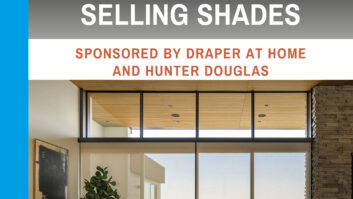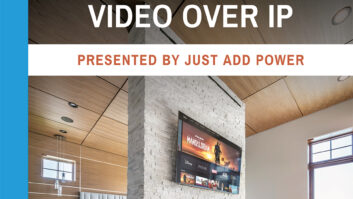I’m going to share a hard truth with you, because friends can be honest with each other, right? Here goes: You’re not perfect.
And whether you’ve been in business for one year or 20 years, fresh out of CEDIA Boot Camp or a grizzled, “I remember when you had to spend 12 hours calibrating a CRT!” vet, you are probably making a number of mistakes that are costing you business and ultimately costing you money.
And these mistakes are frequently two sides of the same coin, either doing too much or too little. Fortunately, these are mistakes that you can rectify. Examine this list of six common business errors and then take an introspective look at your company and see where you can tighten up.
Charging Too Much or Charging Too Little
Money. We’ve all got to make it, not only keep our doors open, but also to pay our employees and feed ourselves and our families. But, there are two big money mistakes you could be making at different stages of the job. Now, you might be thinking that charging too much is a good thing. This “charging what the market can bear” mentality keeps away the tire-kickers, puts more green in the coffers, and establishes you as the high-end solution in town. And if you can get by with that, bully for you. But realize that it is likely costing you business, too. There is business that you don’t even get a shot at because people are staying away due to your, “Man, they are so expensive!” reputation. In a time when you are probably being price shopped on nearly every item and going up against multiple proposals on a project, being the most expensive guy probably won’t win you a lot of new work.
The flip side is not charging enough. Sure, this will land you a lot of jobs, but in the long run, this is going to sap your company of profits and can put you out of business. If you are working on such razor-thin margins that even a slight hiccup on a job puts you into the red, then you need to reexamine your rates. At my company we took a look at our service call rates earlier in the year. On the surface, we thought what we were charging was very profitable. But by the time we calculated how much time it took to prepare for the job, to drive to the job, to load-in and out at the job, to return to the store, and to unload from the job, we realized that we were losing money on some service calls.
Being Over- or Under-Staffed
Employees are the oil that keeps a well-honed company running, and unless you are a very small operation, you’ve got employees. Beyond all of the interpersonal issues that come with having employees, staffing size is a real concern for CI firms. If you have too many employees, you are probably bleeding out cash on your payroll. And with payroll comes taxes, insurance, benefits, etc. Letting go of people stinks—especially if they are good and have been with you for a while—but sometimes you have to cut off a limb to save the body.
Being understaffed is another killer. I wrote about this problem earlier when our company found itself shorthanded. When you are understaffed, the stress levels skyrocket and company morale can plummet. There is only so long that you can ask the staff to put in 12- and 14-hour days, to stay late and “just get it done” before they start to snap. Also, when you are unable to respond to requests in a timely manner, you will lose work and aggravate customers (“I really want to use you, but I just can’t wait three weeks to get a new TV”).
There is likely a “magic number” of employees that works best for your company’s size and business volume, and the sooner you find that the better.
Carrying Too Many or Too Few Brands
What could possibly be the harm in carrying every product under the sun? Well, for one thing, it is way too confusing for customers. Why would they possibly choose this $899 AV receiver over that one or that one or that one (or that one…), when they are all more alike than they are different? Have you ever been to a restaurant where they read you a list of like 15 different salad dressings and someone at the table is, “Wait. Can you read that list again,” (pause while they read), “Umm, I’m sorry, can you read it just one more time…?” It’s confusing. Limiting the choices actually helps the customer to decide.
Choose brands that help you tell a story. “This is what we like for entry-level systems…this is our preferred mid-line solution…we normally reserve this for our high-end systems…” This approach helps your sales team and client focus and more easily make a decision. Also, having a “product of the month” mentality, where you are constantly bringing in the latest “hot” line, makes it tough to show any support to a single brand. If you focus your business on fewer lines, then you’ll likely be able to garner more favorable terms and support from your vendor partners. Furthermore, it makes it difficult for your staff to really know every product you sell when you are selling every product, or are constantly bringing in something new.
Limiting choices is a good thing…to a point. If you carry too few brands, people can feel like they don’t have any choice at all, and you’ll end up losing sales. “Of course that is your favorite (speaker, receiver, TV); it is the only one you sell!” There will always be those people that are married to one specific brand or another (“I’ve always been a Sony TV man. Nothing’s gonna change my mind now!”) and that’s fine. You won’t please everyone that walks into the door. But variety is the spice of life, and having a well-selected product line-up makes it look like you’ve done your homework and really know your stuff.
Over or Under Advertising
Honestly, if you have the money, you probably can’t over-advertise. Just ask Budweiser and Coca-Cola and any of the other companies that dropped $4MM for a Super Bowl ad spot. It keeps your company in the forefront of potential clients and will likely yield results eventually. But I don’t know any AV companies that have bottomless marketing allowances. And If I were to take an informal poll, I bet nearly everyone reading this would say that the majority of their business comes from previous clients and word-of-mouth. Congratulations, because that is the very best kind of business to get. But, there are a lot of people out there looking for AV gear and wanting the services that you offer who don’t know one of your previous clients or one of your preferred builders. How do you reach them? Advertising is a tricky thing; it can cost a ton of money and yield no results. You’ll have to experiment to find out what works for you—TV, radio, mailers, magazines, billboards, phone books, internet, social media… Finding out what works for you and your market—and how little or how much to spend—is key to staying successful and relevant.
Being Over or Under Inventoried
Inventory is expensive. It just sits there like a big, expensive, space-eating lump in the back room. Most agile installation firms look to be as just-in-time as possible, and with many distribution partners featuring multiple shipping facilities around the country, this has become a lot easier to manage. But even still, finding the balance between having too much and too little in stock can end up costing you. With products that change routinely (video and AV receivers) you can find yourself sitting on stock that is suddenly “expired” and much more difficult to sell. And with the virtually non-existent margins in video, being stuck with, or forced to sell at a drastically reduced price, even a single model can sap the profits from dozens of units sold at regular price.
Conversely, having no inventory can cause you to miss out on those walk-in or impulse add-on sales. Also, ordering just the bare product that you need can cause you to miss out on freight discounts and terms (money that can really add up.)
Being Too Early or Too Late to Adopt Change
There’s a reason why they say that early tech adopters live on the “bleeding edge;” it can be risky and expensive. Many times, we are selling ourselves and our word as much or more than any component, and when you make a change too early you can end up having to stand behind something that makes you, and your company, look bad. You might end up getting behind a product that turns out to be vaporware or one that is riddled with bugs and problems that creates a lifetime of service nightmares for your company.
Being too early to embrace new tech can be a killer. But, being the last to the party can mean being left out. Sometimes we cling to old ideas and ways of doing things well past a point where it is prudent to do so. Honestly, I think that our company was about 18 months late in switching from our previous whole-home solution to Control4; we lost bids on a lot of jobs where our previous solution was no longer competitive in the marketplace. Another key is knowing when to cycle out your demo/floor model systems and selling them when they still have some value. I can’t tell you how many thousands of dollars we have lost over the years on projectors in our high-end room. Granted, it is a cost of doing business, but every time you end up sitting on a $15,000 projector that you eventually get rid of for $750 on E-Bay, it stings. Far better to spec these items into a job before the very end of their life to help close a sale and make way for the new model.
John Sciacca is principal of Custom Theater and Audio in Myrtle Beach, SC.







